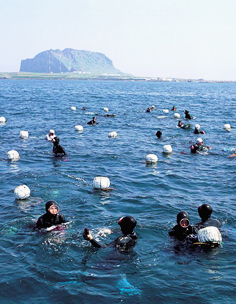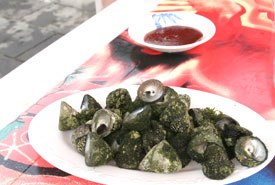Lepas sarapan, kami melawat The mermaids of Jeju, Korean female divers. Di sini kami dapat maklumat cara hidup Haenyo (penyelam wanita) di Haenyeo Museum. Menarik melihat bagaimana semangat kaum wanita (warga emas!) di Jeju menyelam mendapat makanan laut,,,saje je. Mereka di gelar Sea Ladies.
Maklumat 'sea ladies' ini sangat menarik. tetapi diberi ingatan, jangan shoot gambar kalau terserempak. mereka tak suka. Skrol ke bawah, ada saya copy n paste maklumat mengenai 'Haenyeo' atau sea ladies Jeju.
 |
| Bukan, ini bukan 'sea ladies' Jeju. |
 |
| Kami ke sini |
 |
| Bersama Iddin |
 |
| Amal sayang 'ahjumma' |
 |
| Antara yang dipamerkan |
 |
| Jom ke laut ! |
Angin kencang, sejuk...brrrrrr
The Mermaids are called Haenyeo
 The mermaids living on Jeju Island are actually haenyeo, or Korean female divers. What do they do? Unlike fishermen who go out in boats or use a rod or line, these women dive in the ocean without any special tools to gather clams, abalone, or seaweed.
The mermaids living on Jeju Island are actually haenyeo, or Korean female divers. What do they do? Unlike fishermen who go out in boats or use a rod or line, these women dive in the ocean without any special tools to gather clams, abalone, or seaweed.
 The mermaids living on Jeju Island are actually haenyeo, or Korean female divers. What do they do? Unlike fishermen who go out in boats or use a rod or line, these women dive in the ocean without any special tools to gather clams, abalone, or seaweed.
The mermaids living on Jeju Island are actually haenyeo, or Korean female divers. What do they do? Unlike fishermen who go out in boats or use a rod or line, these women dive in the ocean without any special tools to gather clams, abalone, or seaweed.
And they don’t go as fully equipped as scuba divers. All they need is a float to mark their location when they surface, a weeding hoe to dig up abalone and other shellfish that cling to the rocks, and a net to hold their catch. Wearing a lead-weighted vest and goggles, they plunge into the 20-meter depths where they stay underwater holding their breath for two or three minutes. They are so adapted to life beneath the sea, they actually could be mermaids. Once they come back to the surface, they make a whistling sound, which is their unique way of breathing out the carbon dioxide and breathing in fresh oxygen.
Traditionally, Koreans have aspired to have baby boys, because only a man was considered to be the head of a family, but Jeju was different. Here, the birth of a baby girl was so valued that the saying goes: “Have a baby girl, and we will throw a pork barbecue party; have a baby boy, and we will kick his ass.” Since it was the women who worked from morning till night every day, women held a special place in Jeju’s society.
In the past, island girls began gathering clams or abalone by the time they were ten years old. They would dive between six to seven hours a day, but also do farm chores. The common routine was to do farm work, go diving, and then go back to do more farm work. Because of the grueling daily life, female divers had a saying: “Better to be born a cow than a woman.” The life of a haenyeo was not necessarily unhappy, though.
 Female divers usually worked in groups, and during breaks, they built a fire on the beach, dried their clothes, shared some food, and chatted. Diving was also a relatively good source of income. Jeju female divers enjoyed more freedom, independence, and self-respect than other women. They were not only skilled in gathering seafood, but also had great interest in various cultural and social issues. During the colonial period, they led the anti-Japanese campaign and also established cooperatives to preserve marine resources. They also worked to preserve the haenyeo culture. Haenyeos were awarded medals for their contribution during the anti-Japanese campaign, and saw the creation of a monument and a commemorative park in their honor, located in Hado-ri, Jeju-do.
Female divers usually worked in groups, and during breaks, they built a fire on the beach, dried their clothes, shared some food, and chatted. Diving was also a relatively good source of income. Jeju female divers enjoyed more freedom, independence, and self-respect than other women. They were not only skilled in gathering seafood, but also had great interest in various cultural and social issues. During the colonial period, they led the anti-Japanese campaign and also established cooperatives to preserve marine resources. They also worked to preserve the haenyeo culture. Haenyeos were awarded medals for their contribution during the anti-Japanese campaign, and saw the creation of a monument and a commemorative park in their honor, located in Hado-ri, Jeju-do.
Today, haenyeos play the role of guardians of the sea and the ocean’s ecological environment. Their cooperatives operate seafood restaurants and shops, explaining why some restaurants are named Haenyeo Hoetji (Seafood restaurant specializing in raw fish) and Haenyeoui Jip (House of Haenyeo).
While it is not known when the first female divers appeared in Jeju, they are believed to predate the Common Era. Ancient shrines honoring fishermen and female divers indicate that they have been around since humans began gathering food from the sea. And divers have long been a part of Jeju Island. A study conducted during the 1960s of the physiology of female divers (sponsored by the U.S. State Department and conducted by American and Korean scholars) named Jeju Island as the birthplace of Korean female divers. Divers born on the island migrated to other regions after they married. When the number of divers reached the market limits, some moved in search of areas with more abundant shellfish.
During the Japanese occupation, they even went as far as China, Russia, and Japan to make a living. Currently, however, the number of female divers has decreased sharply because of shark attacks and the heart risks caused by diving. In 2002, there were only 5,600 female divers, and more than half were 60 years or older. In ten years, the total number of divers will likely be only half of that number. If you chance to meet one of these special mermaids during your trip to Jeju, that would be your lucky day.



Kak hajah nora...
ReplyDeletememang bestlah perjalanan kak hajah nora ke Korea..
(nak sorokkan dari anak dara saya sebab dia mmg teringin sangat nak kesana...)
Tak pe beri dia tengok. Motivasi untuk study hard and get good results.
Delete